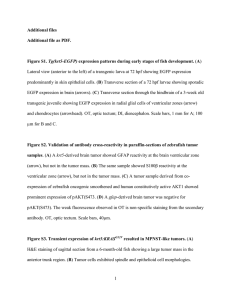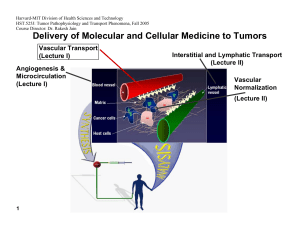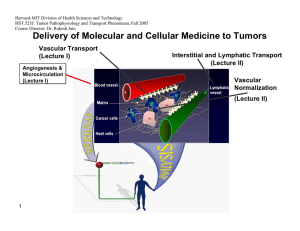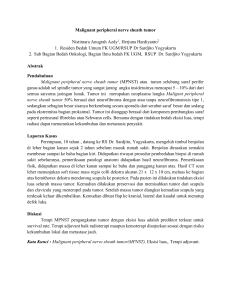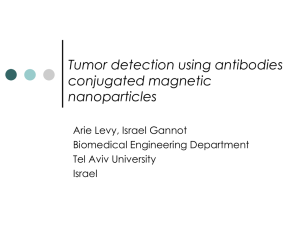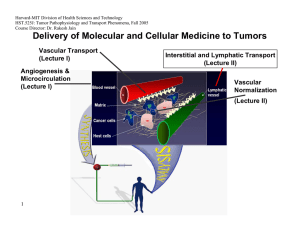Harvard-MIT Division of Health Sciences and Technology
advertisement
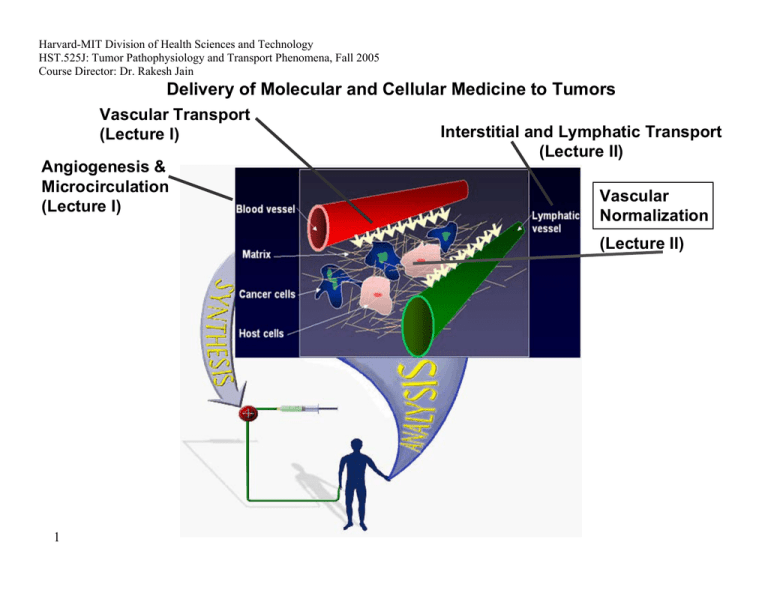
Harvard-MIT Division of Health Sciences and Technology HST.525J: Tumor Pathophysiology and Transport Phenomena, Fall 2005 Course Director: Dr. Rakesh Jain Delivery of Molecular and Cellular Medicine to Tumors Vascular Transport (Lecture I) Angiogenesis & Microcirculation (Lecture I) Interstitial and Lymphatic Transport (Lecture II) Vascular Normalization (Lecture Il) 1 2005 Vascular Normalization R.K. Jain, “Normalizing Tumor Vasculature with Anti-Angiogenic Therapy: A New Paradigm for Combination Therapy," Nature Medicine, 7: 987-989 (2001). C. Willett, Y. Boucher, E. di Tomaso, D. Duda, L. L. Munn, R. Tong, D. Chung, D. Sahani, S. Kalva, S. Kozin, M. Mino, K. Cohen, D. Scadden, A. Hartford, A. Fischman, J. Clark, D. Ryan, A. Zhu, L. Blaszkowsky, H. Chen, P. Shellito, G. Lauwers, and R. K. Jain. “Direct evidence that the VEGF-specific antibody bevacizumab has antivascular effects in human rectal cancer. Nature Medicine, 10:145-147 (2004). R. T. Tong, Y. Boucher, S. V. Kozin, D. J. Hicklin, and R. K. Jain, “Vascular normalization by VEGFR2 blockade induces a pressure gradient across the vasculature and improves drug penetration in tumors,” Cancer Research, 64:3731-3736 (2004). F. Winkler, S. Kozin, R. Tong, S. Chae, M. Booth, I. Garkavstev, L. Xu, D. J. Hicklin, D. Fukumura, E. di Tomaso, L.L. Munn, R.K. Jain. “Kinetics of vascular normalization by VEGFR2 blockade governs brain tumor response to radiation: Role of oxygenation, Angiopoietin-1, and matrix metallproteinases,” Cancer Cell 6: 553-562, 2004. R.K. Jain, “Normalization of the tumor vasculature: An emerging concept in anti-angiogenic therapy”, Science 307: 58-62 (2005). R.K. Jain, “Antiangiogenic therapy of cancer: Current and emerging concepts,” Oncology (Supplement), 19: 7-16 (2005). 2 2005 Leucocyte-Endothelial Interaction in Tumors C. Ohkubo, D. Bigos and R.K. Jain, “IL-2 Induced Leukocyte Adhesion to the Normal and Tumor Microvascular Endothelium In Vivo and its Inhibition by Dextran Sulfate: Implications for Vascular-Leak Syndrome,” Cancer Research, 51:1325-1563 (1991). A. Sasaki, R.J. Melder, T.L. Whiteside, R.B. Herberman, and R.K. Jain, “Preferential Localization of Human A-LAK Cells in Tumor Microcirculation: A Novel Mechanism of Adoptive Immunotherapy,” Journal of National Cancer Institute, 83:433437 (1991). R.J. Melder, A.L. Brownell, T.M. Shoup, G.L. Brownell, and R.K. Jain, “Imaging of Activated Natural Killer Cells in Mice by Positron Emission Tomography: Preferential Uptake in Tumors,” Cancer Research, 53:5867-5871 (1993). R.J. Melder, H.A. Salehi, and R.K. Jain, “Localization of Activated Natural Killer Cells in MCaIV Mammary Carcinoma Grown in Cranial Windows in C3H Mice,” Microvascular Research, 50:35-44 (1995). D. Fukumura, H. Salehi, B. Witwer, R.F. Tuma, R.J. Melder, and R.K. Jain, “TNFa-induced Leukocyte-Adhesion in Normal and Tumor Vessels: Effect of Tumor Type, Transplantation Site and Host,” Cancer Research, 55:4611-4622 (1995). D. Fukumura, F. Yuan, W.L. Monsky, Y. Chen, and R.K. Jain, “Effects of Host Microenvironment of Human Colon Adenocarcinoma,” Amer. J. Pathology, 150:679-688 (1997). K.S. Moulton, R.J. Melder, V. Dharnidharka, J. Hardin-Young, R.K. Jain, and D.M. Briscoe, “Angiogenesis in the huPBLSCID Model of Human Transplant Rejection,” Transplantation, 67:1626-1631 (1999). Y. Tsuzuki, D. Fukumura, B. Oosthuyse, C. Koike, P. Carmeliet and R.K. Jain. “Vascular Endothelial Growth Factor Modulation by Targeting HIF-1α→HRE→ VEGF Cascade Differentially Regulates Vascular Response and Growth Rate in Tumors,” Cancer Research, 60:6248-6252 (2000). 3 2005 Role of Rigidity of Cells in Delivery Sasaki, R.K. Jain, A.A. Maghazachi, R.H. Goldfarb, and R.B. Herberman, “Low Deformability of LAK Cells: A Possiblle Determinant of In Vivo Distribution,” Cancer Research, 49:3742-3746 (1989). R.J. Melder and R.K. Jain, “Kinetics of Interleukin - 2 Induced Changes in Rigidity of Human Natural Killer Cells,” Cell Biophysics, 20:161-176 (1992). R. Melder and R.K. Jain, “Reduction of Rigidity in Human Activated Natural Killer Cells by Thioglycollate Treatment,” Journal of Immunological Methods, 175:69-77 (1994). R.J. Melder, C.A. Kristensen, L.L. Munn, and R.K. Jain, “Modulation of A-NK Cell Rigidity: In Vitro Characterization and In Vivo Implications for Cell Delivery,” Biorheology, 38:151-159 (2001). Z. N. Demou, M. Awad, T. McKee, J. Y. Perentes, X. Wang, L. L. Munn, R. K. Jain and Y. Boucher. “Lack of Telopeptides in Fibrillar Collagen I Promotes the Invasion of a Metastatic Breast Tumor Cell Line”. Cancer Research (in press). Role of RBCs in Adhesion R.J. Melder, L.L. Munn, S. Yamada, C. Ohkubo and R.K. Jain, "Selectin and Integrin Mediated T Lymphocyte Rolling and Arrest on TNF-activated Endothelium is Augmented by Erythrocytes," Biophysical Journal , 69: 2131-2138 (1995). L.L. Munn, R.J. Melder, and R.K.Jain, "Role of Erythrocytes in Leukocyte-Endothelial Interactions: Mathematical Model and Experimental Validation," Biophysical Journal , 71:466-478 (1996). R.J. Melder, J. Yuan, L.L. Munn, and R.K. Jain, “Erythrocytes Enhance Lymphocyte Rolling and Arrest in Vivo,” Microvascular Research, 59: 316-322 (2000). J. Yuan, R.J. Melder, R.K. Jain and L.L. Munn, “A Lateral View Flow System for Studies of Cell Adhesion and Deformation under Flow Conditions,” BioTechniques, 30:388-394 (2001). 4 C. Migliorini, Y.H. Qian, H. Chen, E.B. Brown, R.K. Jain and L.L. Munn, “Red Blood Cells Augment Leukocyte Rolling in a Virtual Blood Vessel,” Biophy. J. 83:1834-1841 (2002). 2005 Role of Angiogenic Factors in Leukocyte Adhesion J. Kitayama, H. Nagawa, H. Yasuhara, N. Tsuno, W. Kimura, Y. Shibata,and T. Muto, “Suppressive Effect of Basic Fibroblast Growth Factor on Transendothelial Emigration of CD4(+) T-Lymphocyte,” Cancer Research, 54: 4729-4733 (1994). R.J. Melder, G. Koenig, B.P. Witwer, N. Safabakhsh, L.L. Munn and R.K. Jain, "During Angiogenesis, Vascular Endothelial Growth Factor and Basic Fibroblast Growth Factor Regulate Natural Killer Cell Adhesion to Tumor Endothelium," Nature Medicine, 2:992-997 (1996). M. Detmar, L.F. Brown, M.P. Schon, B.M. Elicker, P. Velasco, L. Richard, D. Fukumura, W. Monsky, K.P. Claffey, and R.K. Jain, “Increased Microvascular Density and Enhanced Leukocyte Rolling and Adhesion in the Skin of the VEGF Transgenic Mice,” J. Invest. Dermatology, 111:1-6 (1998). R.K. Jain, N. Safabakhsh, A. Sckell, Y. Chen, L.A. Benjamin, F. Yuan, and E. Keshet, “Endothelial Cell Death, Angiogenesis, and Microvascular Function Following Castration in an Androgen-Dependent Tumor: Role of VEGF,” PNAS, 95: 1082010825 (1998). T. Gohongi, D. Fukumura, Y. Boucher, C. Yun, G.A. Soff, C. Compton, T. Todoroki and R.K. Jain, “Tumor-host Interactions in the Gallbladder Suppress Distal Angiogenesis and Tumor Growth: Role of TGFβ,” Nature Medicine, 5:1203-1208 (1999). A. Kadambi, C.M. Carreira, C.-O. Yun, T.P. Padera, D.E.J.G.J. Dolmans, P. Carmeliet, D. Fukumura and R.K. Jain. “Vascular endothelial Growth Factor (VEGF)-C Differentially Affects Tumor Vascular Function and Leukocyte Recruitment: Role of VEGF-Receptor 2 and Host VEGF-A,” Cancer Research, 61: 2404-2408 (2001). 5 2005 Pharmacokinetics and Scale-Up L.E. Gerlowski and R.K. Jain, "Physiologically-Based Pharmacokinetics: Principles and Applications." Journal of Pharmaceutical Sciences, 72: 1103-1127 (1983). L.T. Baxter, H. Zhu, D. Mackensen, and R.K. Jain, “Physiologically Based Pharmacokinetic Model for Specific and Nonspecific Monoclonal Antibodies and Fragments in Human Tumor Xenograft in Nude Mice,” Cancer Research, 54: 1517-1528 (1994). L.T. Baxter, H. Zhu, D.G. Mackensen, W.F. Butler and R.K. Jain, "Biodistribution of Monoclonal Antibodies: Scale-up from Mouse to Man Using a Physiologically Based Pharmacokinetic Model," Cancer Research , 55: 4611-4622 (1995). H. Zhu, R. Melder, L. Baxter, and R.K. Jain, "Physiologically Based Kinetic Model of Effector Cell Biodistribution in Mammals: Implications for Adoptive Immunotherapy," Cancer Research, 56:3771-3781 (1996). R.J Melder, L.L. Munn, B.R. Stoll, E.M. Marecos, L.T. Baxter, R. Weissleder, and R.K. Jain, “Systemic Distribution and Tumor Localization of Adoptively Transferred Lymphocytes in Mice: Comparison with Physiologically-Based Pharmacokinetic Model,: Neoplasia, 4: 3-8 (2002). S.W. Friedrich, S.C. Lin, B.R. Stoll, L.T. Baxter, L.L. Munn, R.K. Jain, “Antibody Directed Effector Cell Therapy of Tumors: Analysis and Optimization Using a Physiologically Based Pharmacokinetic Model” Neoplasia, 4:449-463 (2002). B.R. Stoll, C. Migliorini, A. Kadambi, L.L. Munn, R.K. Jain, “A Mathematical Model of the Contribution of Endothelial Progenitor Cells to Angiogenesis in Solid Tumors: Implications for Anti-Angiogenic Therapy”. Blood, 103:2555-2561 (2003). 6 2005 Outline 7 • Paradox • Normalization Hypothesis • Preclinical Evidence • Clinical Evidence • Molecular Mechanisms • Conclusions 2005 Paradox Chemotherapy or radiation therapy Anti-angiogenic therapy 8 ? 2005 Outline 9 • Paradox • Normalization Hypothesis • Preclinical Evidence • Clinical Evidence • Molecular Mechanisms • Conclusions 2005 10 Normalization Hypothesis Normal Abnormal Normalized Inadequate (Tumor begins to die/decrease) Figure by MIT OCW. After Jain, 2001. 2005 Can Anti-Angiogenic Therapy Normalize Tumor Vessels? Anti Pro Anti Pro Anti Anti Pro Pro 11 Reference: Jain, Nature Med. (2001), Science (2005) 2005 Outline 12 • Paradox • Normalization Hypothesis • Preclinical Evidence • Clinical Evidence • Molecular Mechanisms • Conclusions 2005 13 Tumor relapse after regression Courtesy of National Academy of Sciences, U.S.A. Used with permission.�� Source: Jain, Rakesh K., Nina Safabakhsh, Axel Sckell, Yi Chen, Ping Jiang, Laura Benjamin, Fan Yuan, and Eli Keshet, "Endothelial cell death, angiogenesis, and microvascular function after castration in an androgen-dependent tumor: Role of vascular endothelial growth factor." Proc Natl Acad Sci 95 (1998): 10820-10825. (c) National Academy of Sciences, U.S.A. 2005 Normalization of tumor vasculature by hormone withdrawal Courtesy of National Academy of Sciences, U.S.A. Used with permission.�� Source: Jain, Rakesh K., Nina Safabakhsh, Axel Sckell, Yi Chen, Ping Jiang, Laura Benjamin, Fan Yuan, and Eli Keshet, "Endothelial cell death, angiogenesis, and microvascular function after castration in an androgen-dependent tumor: Role of vascular endothelial growth factor." Proc Natl Acad Sci 95 (1998): 10820-10825. (c) National Academy of Sciences, U.S.A. 14 50 45 40 35 30 25 20 15 10 5 0 Permeability Vessel Diameter (⎧m) 3.5 3 2.5 Sham 2 Castration 1.5 1 0.5 Day 7 Day 14 Day 18 Day 23 Day 28 0 Day 7 Day 14 Day 18 Day 23 Day 28 2005 Can Herceptin normalize tumor vessels? Images removed for copyright reasons. See: Fig. 1a in Izumi, Y., L. Xu, E. di Tomaso, D. Fukumura, and R. K. Jain. "Tumour biology: herceptin acts as an anti-angiogenic cocktail." Nature 416 (2002): 279-280. Vascular permeability (10-7cm/sec) l Control l Herceptin MDA361HK 15 tumor 10 Treatment 5 * * 0 day 0 15 day 15 Max size VEGF in vitro in vivo C C H H 2005 VEGF Blockade Normalizes Tumor Vasculature Normalization Hypothesis Normal Day 2 – Normalized 16 Day 0 - Abnormal Day 5 - Inadequate Figure by MIT OCW. After Jain, 2001. 2005 DC101 fortifies tumor vessels Normal arteriole control DC101 17 Reference: Tong et al. Cancer Research (2004) 2005 18 Decrease in interstitial fluid pressure (IFP) by VEGF blockade Courtesy of National Academy of Sciences, U.S.A. Used with permission. Source: Jain, Rakesh K., Nina Safabakhsh, Axel Sckell, Yi Chen, Ping Jiang, Laura Benjamin, Fan Yuan, and Eli Keshet, "Endothelial cell death, angiogenesis, and microvascular function after castration in an androgen-dependent tumor: Role of vascular endothelial growth factor." Proc Natl Acad Sci 95 (1998): 10820-10825. (c) National Academy of Sciences, U.S.A. 2005 19 Normalization Hypothesis Normal Abnormal Normalized Inadequate (Tumor begins to die/decrease) Figure by MIT OCW. After Jain, 2001. 2005 Outline 20 • Paradox • Normalization Hypothesis • Preclinical Evidence • Clinical Evidence • Molecular Mechanisms • Conclusions 2005 Protocol of Clinical Trial 50.4Gy EBRT / CTX Avastin: Day : -3 1 3 12 √ √ Blood/urine √ Tumor Biopsy √ √ IFP √ √ Imaging √ √ 21 15 29 32 √ 43 Surgery 93 103 √ √ √ Reference: Willett et al. Nature Medicine (2004) 2005 Response to anti-VEGF treatment in colorectal cancer Surgical specimen Endoscopic view Ulce r Before treatment 12 days post Avastin infusion 7 weeks post treatment 22 Reference: Willett et al. Nature Medicine (2004) 2005 Endoscopic IFP Measurements 23 Reference: Willett et al. Nature Medicine (2004) low dose high dose 2005 Tumor vascular parameters from histology 24 Reference: Willett et al. Nature Medicine (2004) 2005 PET Scan: Tumor FDG Uptake Reference Corrected SUV (Rectal ROI) Sagittal PET scans: Patient #1 Pre-Tx 25 Day 12 5 mg/kg BV 10 mg/kg BV 12 8 4 n=4-6, *P < 0.05 Bar = SEM * 0 Pre-Tx Day 12 Pre-surgery Pre-Surgery Reference: Willett et al. Nature Medicine (2004) 2005 Outline 26 • Paradox • Normalization Hypothesis • Preclinical Evidence • Clinical Evidence • Molecular Mechanisms • Conclusions 2005 Cranial Model – Orthotopic Tumor Model Figure by MIT OCW. After Jain. 27 2005 Mechanism of Vascular Normalization Mean Diameter Relative mean diameter 0.5 2.0 1.0 0.0 * * * Day 2 Day 5 Day 8 After treatment with DC101 Vessel Density 0.0 IgG DC101 DC101 DC101 DC101 control Days of treatment: 1 2 5 8 Relative vessel density Fraction of NG2 positive vessel perimeter 1.0 2.0 1.0 * 0.0 * Day 2 Day 5 Day 8 After treatment with DC101 28 Figure by MIT OCW. Figure by MIT OCW. 2005 Inhibition of Ang-1/Tie2 Signalling Prevents Pericyte Recruitment to Tumor Vessels 1.0 Image removed for copyright reasons. Source: Fig. 2a in Winkler et al. "Kinetics of vascular normalization by VEGFR2 blockade governs brain tumor response to radiation: Role of oxygenation, angiopoietin-1, and matrix metalloproteinases." Cancer Cell 6 (2004): 553-563.� 0.5 � DC101 + ⟨Tie2 AB 29 Figure by MIT OCW. DC101 DC101+ siAng1 IgG + siAng1 DC101 + αTie2 AB IgG + αTie2 AB DC101 2 DC101 1 DC101 + αTie2 peptide Days of treatment: DC101 0.0 IgG control Fraction of NG2 positive vessel perimeter rat IgG + ⟨Tie2 AB 5 8 Image removed for copyright reasons. Source: see above. 2005 The thickened basement membrane (BM) of tumor vessels normalizes after VEGFR2 blockade Images removed for copyright reasons. Images removed for copyright reasons. Thickness of BM (µm) Source: Fig. 4a in Winkler, et al. "Kinetics of vascular normalization by VEGFR2 blockade governs brain tumor response to radiation: Role of oxygenation, angiopoietin-1, and matrix metalloproteinases." Cancer Cell 6 (2004): 553-563. 3 # 2 A B C *+# *+ *+ D E 1 A 0 Images removed for copyright reasons. 30 A = Untreated B = rat IgG C = DC101 1d D = DC101 2d E = DC101 5d F = DC101 8d Figure by MIT OCW. D Normal Brain U87 Tumor F 2005 BM thickening is common in human GBMs Images removed for copyright reasons. Source: Fig. 4b in Winkler et al. "Kinetics of vascular normalization by VEGFR2 blockade governs brain tumor response to radiation: Role of oxygenation, angiopoietin-1, and matrix metalloproteinases." Cancer Cell 6 (2004): 553-563. 31 Images removed for copyright reasons. Source: Fig. 5a in Winkler et al. "Kinetics of vascular normalization by VEGFR2 blockade governs brain tumor response to radiation: Role of oxygenation, angiopoietin-1, and matrix metalloproteinases." Cancer Cell 6 (2004): 553-563. Figure by MIT OCW. 2005 The Vascular Normalization Time Window Normalization Time Window Ang1 MMPs Basement Membrane Thickness Pericyte Coverage Vascular Morphology Vascular Density Diameter Day 0 33 Figure by MIT OCW. After Winkler et al, 2004. Day 8 2005 DC101 Decreases Tumor Hypoxia During the Vascular Normalization Time Window Images removed for copyright resons. Source: Fig. 1b in Winkler et al. "Kinetics of vascular normalization by VEGFR2 blockade governs brain tumor response to radiation: Role of oxygenation, angiopoietin-1, and matrix metalloproteinases." Cancer Cell 6 (2004): 553-563. Hypoxic Tumor Fraction 0.6 0.5 0.4 # 0.3 *+# 0.2 0.1 0.0 *+ Untreated IgG Controls 34 1d 2d *+# 5d DC101 Treated Figure by MIT OCW. 8d 2005 Radiation Therapy Acts Synergistically with VEGFR2 Blockade During the Normalization Time Window DC101 Day -9 Tumor Growth Delay (days) Radiation -6 RT1 -3 0 RT2 3 RT3 6 RT4 RT5 *+ 20 10 0 C DC101 RT RT1 RT2 RT3 RT4 RT5 + DC101 35 9 Figure by MIT OCW. After Winkler et al, 2004. 2005 The Vascular Normalization Time Window Normalization Time Window Ang1 MMPs Basement Membrane Thickness Pericyte Coverage Vascular Morphology Vascular Density Diameter Day 0 Day 8 36 Figure by MIT OCW. After Winkler et al, 2004. 2005 Outline 37 • Paradox • Normalization Hypothesis • Preclinical Evidence • Clinical Evidence • Molecular Mechanisms • Conclusions 2005 Tumor vasculature 39 Reference: Brown et al. Nature Medicine, 2001 2005 Normal vasculature 40 Reference: Brown et al. Nature Medicine, 2001 2005 Pre-clinical and clinical data Effects of anti-angiogenic therapy Pre-clinical data Clinical data Blood volume Ļ (-72%) Ļ (-26%) Vascular density Ļ (-19%) Ļ (-47%) Permeability Ļ (-62%) PS product Interstitial fluid pressure Ļ (-49%) Ļ (-71%) Perivascular cell coverage Ĺ (21%) Ĺ (80%) Apoptosis Ĺ (190%) Ĺ (112%) Ĺ* Ĺ (1109%) Ļ (~-92%)† Ļ (~-9%) Plasma VEGF level Progenitor cells 42 - (no changes) 2005 Evidence from Other Labs Supporting Vascular Normalization Anti-angiogenic agent Target/ action Other therapies A.4.6.1 VEGF CPT-11 Thalidomide Inhibits bFGF and VEGF X-ray Bevacizumab VEGF SS1P and HA22 (immunotoxins) •Combination treatment (additive anti-tumor activity) Bang et al. 2005 SU11657 VEGFRs PDGFRs Pemetrexed and radiation •Decreased vascular density •Lower IFP •Radiation therapy given after SU11657 is more effective Huber et al. 2005 AG013736 VEGF-Trap VEGFRs VEGF N/A •Decreased vascular density •Decreased endothelial fenestrations •Improved perivascular cell coverage DC101 VEGFR2 N/A •Decreased vascular density •Increased perivascular cell coverage •Improved basement membrane coverage •Down-regulation of MMP9 and MMP13 43 Effects •Decreased vascular density •Increased intratumoral CPT-11 conc. •Increased tumor perfusion (Hoechst 33342) •Induced tumor reoxygenation •Lower IFP •Increased perfusion •Radiosensitization within a time window Reference Wilders et al. 2003 Ansiaux et al. 2005 Inai et al. 2004 Vosseler et al. 2005 2005 Proposed Normalization Window Proposed Normalization Window Normalization Window Excessive Pruning Dose Toxicity to Normal Tissue No Effect on Vessels Time Figure by MIT OCW. After Jain, 2005. 46 2005 Problems with anti-cancer treatments Physiological barriers impede drug delivery Genetic & epigenetic mechanisms lead to drug resistance Anti-angiogenic therapy has the potential to: • overcome physiological and drug resistance • normalize tumor vasculature 47 Courtesy of Lance Munn. Used with permission. 2005 “ Much of the history of biology can be expressed metaphorically as a dynamic tension between between equilibrium unit reduction in this and and tension aggregate, holism. is An neither possible nor desirable… In tandem the two kinds of endeavors nudge the discipline forward.” 49 -Edward O. Wilson Pelegrino University Professor, Harvard
